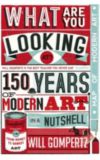
11 Sep 2012 00:08:37
Gompertz has written an energetic and comprehensive romp through modern art, starting unusually early in the 19th century and continuing right up to Ai Weiwei. He's got them all in, from Courbet to Rothko to Hirst. Although his book is short on illustrations for a beginner's guide, it's a well-balanced history. He gives the right amount of space to the European postwar avant garde including Lucio Fontana, Yves Klein and Joseph Beuys. At the end there is an appropriate page or two about the dealer Larry Gagosian, who with 11 galleries dotted around the world's capital cities embodies the hyper-commerciality of art today.
It's refreshingly up-to-the minute, as you might expect from an arts correspondent – there's a vivid description of MoMA's 2010 blockbuster exhibition with performance artist Marina Abramovic. There's a good section on female modernists, who were not treated seriously enough by their fellow male artists or, until recently, by curators and historians. And Gompertz doesn't make the mistake of many more analytical critics, including Robert Hughes and Rosalind Krauss, of finding all modern art totally brilliant until they get to the last 10 years.
He reorients modern art, as other recent art historians have done, away from cubism and painting and towards Duchamp and the readymade. This is the fashionable thing to do because it helps make sense of Warhol and Hirst, but it's not the be-all and end-all. You could argue that the real source from which modern art flows is neither Picasso's Les Demoiselles nor Duchamp's urinal, but something by the Greek-Italian surrealist Georgio De Chirico – or even Gustave Moreau, a 19th-century French artist who embraced traditional history painting, symbolism, dreams and abstraction (in the sense of not finishing all his pictures).
Gompertz makes some nice connections: he finds the roots of Richard Long's walks-as-art in Bruce Nauman's studio practice, and then links that forward to the art-walks of Mexico-based Francis Alÿs. Best of all, he comes up with a new "ism" to describe the art of Hirst, Murakami and Koons. He says postmodernism has been replaced by "entrepreneurialism", though to my mind cynicism would be a better word.
Yet this is a patchy book, its language often formulaic. Duchamp, we're told, enjoyed the "sensuous charms" of New York and "the sun's warm embrace". The descriptions of artists and their milieus are frequently cartoon-like. Gompertz's portraits of the alcoholic genius Jackson Pollock and the libidinous, bargain-hunting collector Peggy Guggenheim do not feel insightful. In the final chapter, after enthusing about Banksy, he writes: "If Marcel Duchamp were alive today he would be a street artist." Really? The ultra-theoretical cool-headed conceptualist who spent much of his life living off the super-rich? I don't think so.
Gompertz's criticism is zesty, resolutely non-theoretical and often ends in dubious hyperbole. Sol LeWitt's sculptures of cubes apparently relate to the space age because they were "exploring the same principles at the same time as scientists were designing rockets to put man on the moon". He indulges in that common failing of art criticism: the deployment of phrases that could be applied to a thousand artists. Pollock's drip paintings express "unfettered emotion". Gauguin has "the ability to communicate ideas and feelings universal to us all in a unique way". Still, he does wittily describe Marc Quinn's Blood Head as a "sorbet".
The real problem with this book is not the art history but the reader that it constructs. It's not surprising that Gompertz – BBC arts editor since 2009 – should have adopted the approach he does because TV executives today all make the same mistake of imagining that their "audience" don't know anything about, and don't much like, contemporary art. But most people I meet are pretty clued-up about it, and I've hardly ever met anyone under 70 who thinks that Duchamp's urinal or Carl Andre's bricks shouldn't be considered art. Gompertz writes that an Anthony Caro sculpture "at first glance appears to be the sort of twisted configurations a young child might make out of pipe-cleaners and cardboard". It doesn't to me, and never did. Gompertz is contradictory, because at the same time he is always reminding the reader – correctly – that we live in an age where art is more popular and visible than ever before.
Reading this book made me feel like an old fogey who worries that life and culture are leaving them behind and they'd better make an effort to catch up. I felt better remembering myself as the 14-year-old I once was, falling in love with art but knowing little about it, daunted by thick, complicated volumes of history. For such a person, this book would work well – but you'd need to follow it up quickly with Art Since 1900 by Hal Foster, Rosalind Krauss and others, which is at the serious but still digestible end of the modern art history spectrum.

